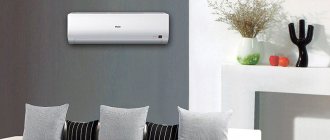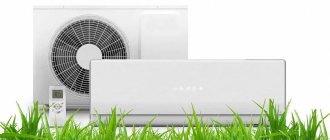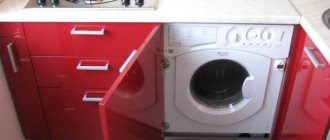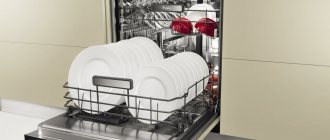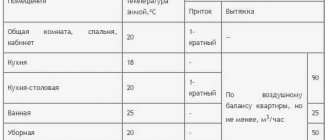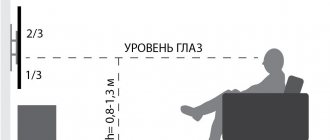Air conditioners and split systems with FREE installation
Most split systems, in addition to cooling, also work for heating. This function is especially relevant in the off-season. In private homes, the device sometimes serves as the main source of heat.
Is this heating method effective and what conditions need to be created for a split system in winter, read this article.
How does an air conditioner work for heat?
First, let's look at how the cooling process occurs:
- Freon in the form of gas enters the compressor, where it is compressed and heated to +70–90 C°.
- The hot refrigerant flows into the condenser (located in the outdoor unit), where it turns into a liquid state.
- The condensation process is accompanied by cooling of the freon with the accompanying release of heat.
- The refrigerant is then sent to the evaporator of the indoor unit, where it becomes a gas, releasing cold and absorbing heat from the room.
- Afterwards the whole path is repeated.
To start the reverse process, that is, to obtain heat, air conditioners use a four-way valve. It changes the direction of freon circulation. As a result, the external unit becomes an evaporator, and the cold is discharged outside. The indoor unit functions as a condenser in which the freon is cooled and releases heat.
How does air conditioning heat up and why is it effective?
Briefly about how the process works:
The compressor of the external unit compresses the freon, after which it heats up and moves through the tubes into the internal device.- In the “heat” mode, heated freon enters the indoor unit and transfers heat to the room air (through a heat exchanger).
- Having given off heat, the freon “cools down” and, already cooled, enters the heat exchanger of the external unit.
- Through an external heat exchanger, the residual “cold” is released to the street air. “Cold energy” (so to speak) is transmitted even when it’s not warm outside!
- After this, the freon enters the compressor again, and the process repeats.
Thus, it turns out that “electrical energy” (during the operation of the compressor) is spent only on the TRANSFER of “thermal energy” from the street. For example, to produce 2000 W of heat in a room, an air conditioner will consume only 600 W of electricity. Any traditional heaters spend energy not on transferring heat, but on CONVERTING it from electricity. And in order to produce the same 2000 W of heat they must consume 2000 W of electricity.
Why, when the “split” is operating for heating, does it behave differently than when operating for cooling?
The normal operation of the air conditioner for cooling is rarely in doubt, and you get used to its “behavior”. But as soon as you switch to the opposite mode, questions immediately arise. Not surprising! After all, the indoor unit periodically quiets down !
When you use the air conditioner in cooling mode, the indoor fan rotates continuously and the blinds operate in the set mode. In this case, only the flow temperature changes. And when heating mode is turned on, the internal fan stops when the heat exchanger is cold. There's a reason for this! And then we will look at why this happens.
What is better to warm up: air conditioning or heater
During the off-season, people most often use heaters. Their main disadvantage is high energy consumption with low output. For example, an oil heater uses 2 kW per hour at the same power rating.
Understanding how an air conditioner works for heating an apartment, it is not difficult to guess that it will be more profitable for heating. The split system does not have a heating element, and electricity is only needed to operate the motor and fan. Heat will be supplied to the room due to freon condensation. When a split system consumes 700 W of electricity, it emits about 3 kW of heat.
Setup recommendations
Before turning on the warm air on the air conditioner, you must carefully study the operating instructions. Every manufacturer tries to stand out in order to attract new customers. For this purpose, some features are often introduced into the rules for using air conditioners. Thus, it is difficult to say exactly how to set the air conditioner for heat, because there are a large number of models of different brands on the market. However, there are several general points that will help solve the problem.
First way
First you need to carefully study the remote control of the unit. If it has a Mode button, then there should be no problems. It allows you to turn on one or another operating mode of the device. It must be pressed until the word Heat or an icon with a sun appears on the display. Then you will need to set the desired temperature that the air conditioner will maintain.
To do this, press the “+” and “-“ keys. You should also remember that during such manipulations the remote control must be pointed towards the unit. The last step is to confirm the settings changes. Various keys can be used for this purpose, for example ON. It is worth remembering that the air conditioner may require several minutes to change its operating mode, most often about five.
We recommend that you read: The benefits and harms of air ionizers for an apartment
Second method
Often there is no Mode key on the remote control. In such a situation, you don’t have to worry that you won’t be able to put the device into heating mode. You need to carefully examine the remote control again for icons like “sun”, “droplet”, “snowflake”, etc. The heating mode is activated by the button with the first icon. Further adjustment is to set the desired room temperature.
You should also remember that you can switch the operating mode of the unit without the remote control, i.e. directly on the air conditioner. It is possible that there is no Mode or “sun” mode on the remote control. In this case, the purchased device is simply not designed to operate in heating mode. Most likely, it was an inexpensive model that does an excellent job of maintaining a comfortable microclimate in winter. If you know for sure that the air conditioner is capable of heating, but the function cannot be activated, then you should contact a service center.
Necessary conditions for correct operation of the air conditioner in winter
Split systems are most often used in the off-season, when central heating has already been turned off and has not yet been turned on.
Non-inverter air conditioners and inexpensive inverter air conditioners can be operated at outdoor temperatures not lower than -5-7 C°.
Middle-class inverter split systems operate at temperatures outside the window of -15 C°. Models from the premium segment can be turned on for heating even in 20-degree frost. To operate more efficiently, such devices take part of the air from the room, which allows them to compensate for smaller temperature differences. Also, in expensive models, high-quality freon flows, which boils at -30..-35, and not -18 C°.
If you only need to heat the apartment before turning on the heating, you can use an inexpensive split system. If you need to heat the room in severe frosts, give preference to more expensive models.
The operating conditions of air conditioners are specified in the operating manual. Check with the seller for the maximum permissible values to guide you when choosing a suitable device.
Air conditioning heating in winter: pros and cons
An air conditioner is a special household appliance designed to cool air. Manufacturers of climate control equipment equip modern split systems with a heating function, which allows the owner to operate the air conditioner not only in summer, but also in the cold season, creating a warm, comfortable atmosphere in the room. Thanks to the built-in settings system, the user can set the required air temperature in the room.
The heating option is an undeniable plus of climate systems. But there are also disadvantages.
Features and disadvantages of heating with air conditioning:
- An air conditioner is not a full-fledged heating device, so many manufacturers recommend using them as an additional heat source or for heating rooms in the off-season, when the central heating system is not yet operating. But if you choose an air conditioner with sufficient power for the heated area of the room, such a device will completely replace conventional radiators.
- Split systems cannot be used for heating if the outside temperature is below the critical temperature indicated in the user manual. As a rule, the maximum value of many models is –100, –150. Thus, for many northern regions of Russia, cold winter weather becomes a serious obstacle to the operation of climate control equipment for heating. The only way out is to purchase a special winter kit for connecting to an air conditioner, which allows you to operate the equipment at high sub-zero temperatures.
- In the southern regions, where the air temperature in winter rarely drops below -100, such a device can become a full-fledged source of heat, taking into account the correctly selected power.
- The air conditioner operates from the mains and uses a certain amount of energy during its operation. During the winter season, the device operates at high power and consumes more energy. The owner is advised to calculate in advance how profitable it will be for him to operate the air conditioner for heating, or whether it is cheaper to heat with convectors or other types of heaters in the winter season.
How should an air conditioner work for heating in winter?
If the device can operate at temperatures down to minus 20 degrees, then it can be turned on at -15-18 C°. The difference between the operating temperature and the starting temperature is 2-5 degrees. This will be reflected in the operating instructions.
The device must be warmed up before active use. For this:
- Set the room temperature parameters to around 18-21 °C and turn on the split.
- Set the blower speed to minimum.
- Let the system operate in this mode for about 5-10 minutes.
Then set the desired temperature and give the system time to heat the room.
At what subzero temperature can you turn on the air conditioner for cooling?
“For cooling” it is allowed to use a split system down to low temperatures (-3 - -5˚С) (must be specified in the operating instructions). This limitation is due to the fact that
- The oil in the compressor is thick, and turning on the air conditioner can lead to its failure.
- The water at the drainage outlet may freeze, which will lead to a “leakage” of the indoor unit.
The “heating” mode at positive temperatures is very effective in the autumn-spring period (when the main heating is not turned on). Operating the air conditioner “for heat” is unacceptable at temperatures below zero. For these purposes, it is necessary to use other devices. For example, heat pumps, convectors, heaters, etc.
Good to know: Air conditioner failure due to non-compliance with temperature parameters is not covered under warranty. In winter, it is better to disconnect the air conditioner from the mains. And if there is a possibility that icicles will hit the external unit (or a large amount of snow will fall off), it is imperative to protect the air conditioner with a visor or at least cover it with something.
Any air conditioner is designed to cool the air in a room. But in the cold season, many users use this device for heating. However, before you start using equipment in this way, you need to understand how to properly start heating with an air conditioner. This information will help prevent mistakes in operating expensive equipment.
Does the air conditioner wear out during cold periods?
Non-inverter models experience heavy loads in cold weather. Any system contains a lubricant that comes into contact with freon. As the temperature drops, it thickens, and in severe frosts it begins to delaminate, which can lead to breakage.
Also, thick oil does not have time to lubricate the compressor. The latter has to work with increased load, which reduces the service life.
Inverter air conditioners are less susceptible to wear and tear, as they operate constantly, periodically reducing speed. As a result, the oil circulates without stopping, thickening slightly. This results in less wear on the compressor.
If the air conditioner is designed for mild frosts, a winter kit will help minimize the risk of breakdown. It will heat the outdoor unit's pan and drain pipe, and also regulate the fan speed.
We told you how the air conditioner works in heating mode. If you have any questions about choosing a split system for all-season use, we will help you choose the right model for your home. Call us by phone or leave a request for a consultation.
Features of operation in winter
To maintain comfortable conditions during the cold season without damaging the device, you must carefully study the instructions . It indicates the temperature range in which the unit is able to operate with maximum efficiency. Most often it ranges from -5 to 25 degrees.
However, in summer the unit operates at higher ambient temperatures. At the same time, its performance decreases, but it does not fail. But in winter, violation of the operating conditions of the air conditioner can lead to unpleasant consequences. In such a situation, you should understand how to turn on the air conditioner for heat while maintaining the operation of the unit.
We recommend that you read: Column air conditioners
To do this you will have to understand what is happening. In most budget models, the compressor and condenser are located in the outdoor unit. If the outside temperature drops below the minimum permissible level, the oil in the compressor becomes thicker. As a result, it ceases to properly lubricate the moving parts of the device, which leads to premature failure of the unit.
When it is necessary for the air conditioner to blow warm air, the refrigerant must take heat energy from the environment and deliver it to the room. At low temperatures, freon is not able to heat up to the desired state, and then the efficiency of the unit decreases. It should also be remembered that in severe frost, phase transitions of the refrigerant fail.
If freon does not enter the compressor in a gaseous state, then water hammer is possible. When it is necessary to adjust the air conditioner to warm air, while maintaining the functionality of the unit, then you need to select the device in accordance with the operating conditions.
Rules for choosing an air conditioner for heating
Before you start choosing a device, it is important to know that you can turn on the air conditioner for heating in winter when the outside temperature is at least -25 degrees. If it gets colder, the functioning of the built-in coolant circuits will be disrupted. I chose the device based on the following rules:
- I analyzed the temperature outside in my region. Here it is important to take into account the minimum to which the thermometer drops.
- I estimated the required power for my premises. I recommend choosing it so that the power is enough for at least two rooms.
- Determined the presence of additional functions. For example, protection against freezing of oil and condensate, as well as air ionization will be very useful.
- The air conditioner should consist of two units (internal and external) by default, otherwise you will have to purchase another one and install it separately.
- He clarified the availability of additional connections, such as underfloor heating or water heating. In this case, the design of the air conditioner must include a hydraulic unit. This criterion is not required to be taken into account .
As you can see, I am more inclined to use systems with additional capabilities, since an air conditioner with a heating function in winter must be capable of something else in order for it to be considered rational and highly efficient.
This video describes how heating with an air conditioner is carried out from the personal experience of one of the users
Split system and features of operation in heating mode
A split system for heating a house is the same air conditioner, but consisting of two units (internal and external). These blocks are interconnected by a tube in which freon moves and heat exchange occurs between the external and internal blocks.
When choosing a device, it is the indoor unit that deserves special attention, since it is important to choose it correctly in terms of power. This parameter directly depends on the area of the room for which the air conditioner is selected.
Source koenigclimat.ru
Heating using a split system will occur according to the following scheme:
- freon is heated as a result of heat transfer;
- then it goes to a heat exchanger, in which it shares heat with water;
- the liquid passes through special channels located along the contours of the pump;
- Afterwards, the hot medium leaves the split system and then passes to the consumer through a special pipeline.
Air conditioners with heating have a higher coefficient of performance (efficiency) than conventional devices with a monoblock (has one block).
Source tenki.ru
